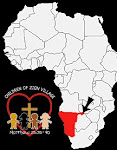
So I thought I’d let you know a little bit about the physical aspect of my new world over here. Namibia is one of the most scarcely populated countries in Africa with a population of only 2 million. The Caprivi Region is the small northeastern “panhandle” and, depending on the map you use, it is often even left off :-( It is a rather diverse little panhandle though as it borders Angola, Zambia, Zimbabwe, and Botswana. The population of the Caprivi is about 80,000 and most live in traditional villages. Agriculture is the main livelihood in these parts and the main crops include Mahangu (millet), sorghum, and maize. The literacy rate is 78% (for those over 15). Life expectancy is 41 and 43 for males and females respectively. Though small, the AIDS/HIV pandemic runs very rampid and, as a result, the Caprivi is one of the most densely populated areas of orphans in the world. The Caprivi is the second highest HIV-stricken region in the world next to Botswana and there are roughly 12,000 orphans here in the Caprivi alone.
Katima, formerly (thank goodness) known as Schukmannsburg, is the main town in the Caprivi and is located on the eastern edge bordering Zambia. The mighty Zambezi, the forth longest river in Africa, runs 2700 km from northwest Zambia, along the border between Namibia and Zambia, right along the gates of our compound here at COZV, and then on to the vast Indian Ocean. COZV is located about 10 kilometres outside of Katima, 4 km being a dirt road back towards the riverside. Katima is a “fully functional” town that includes banks, countless china shops, a hospital, a post office, a few restaurants, 2 (going on 3) gas stations, 2 main grocery stores, a “Sam’s Club” warehouse (probably kept in business by the grocery shopping needed for 60 kids here), a craft market, many little convenient stores, and even a little airport. However, it is 1250 km from Windhoek, the capital of Namibia.
The climate here of rainy and dry seasons results in the river rising half the year and then receding the rest. It will rain about 21- 27 inches per year in this semi-arid tropical savannah with its peak wet months being January and February. During the winter (June-Sept) it will get rather cold at night, around 35-40 degrees Fahrenheit, but will become very nice through the day peaking at around 70 degrees and always (knock on wood) sunny and dry. Fall (Sept-Nov) has the hottest months and temperatures will reach the upper 90's or above 100 degrees Fahrenheit, though not as humid as back home. The summer (Dec-March) is the rainy season peaking, as I said before, in January and February.
Katima, formerly (thank goodness) known as Schukmannsburg, is the main town in the Caprivi and is located on the eastern edge bordering Zambia. The mighty Zambezi, the forth longest river in Africa, runs 2700 km from northwest Zambia, along the border between Namibia and Zambia, right along the gates of our compound here at COZV, and then on to the vast Indian Ocean. COZV is located about 10 kilometres outside of Katima, 4 km being a dirt road back towards the riverside. Katima is a “fully functional” town that includes banks, countless china shops, a hospital, a post office, a few restaurants, 2 (going on 3) gas stations, 2 main grocery stores, a “Sam’s Club” warehouse (probably kept in business by the grocery shopping needed for 60 kids here), a craft market, many little convenient stores, and even a little airport. However, it is 1250 km from Windhoek, the capital of Namibia.
The climate here of rainy and dry seasons results in the river rising half the year and then receding the rest. It will rain about 21- 27 inches per year in this semi-arid tropical savannah with its peak wet months being January and February. During the winter (June-Sept) it will get rather cold at night, around 35-40 degrees Fahrenheit, but will become very nice through the day peaking at around 70 degrees and always (knock on wood) sunny and dry. Fall (Sept-Nov) has the hottest months and temperatures will reach the upper 90's or above 100 degrees Fahrenheit, though not as humid as back home. The summer (Dec-March) is the rainy season peaking, as I said before, in January and February.









